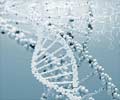Researchers have safely transferred a gene to produce a protein necessary for healthy muscle fiber growth into three teenagers with limb-girdle muscular dystrophy.
Researchers have safely transferred a gene to produce a protein necessary for healthy muscle fiber growth into three teenagers with limb-girdle muscular dystrophy.
The research has been done at the University of Florida (UF), Nationwide Children’s Hospital in Columbus, Ohio, and The Ohio State University."We think this is an important milestone in establishing the successful use of gene therapy in muscular dystrophy," said Dr. Jerry Mendell, director of the Center for Gene Therapy in The Research Institute at Nationwide Children’s Hospital and the lead author of the study.
"This trial sets the stage for moving forward with treatment for this group of diseases and we are very pleased with these promising initial results. In subsequent steps we plan to deliver the gene through the circulation in hopes of reaching multiple muscles. We also want to extend the trials over longer time periods to be sure of the body’s reaction," added the professor of Pediatrics and Pathology at The Ohio State University College of Medicine.
The researchers point out that limb-girdle muscular dystrophy actually describes more than 19 disorders that occur because patients have a faulty alpha-sarcoglycan gene. In each of the disorders, the muscle fails to produce a protein essential for muscle fibers to thrive.
The disease, which can hit both children or adults, causes their muscles to get weaker throughout their lifetimes.
During the trial, the researchers evaluated the safety of a modified adeno-associated virus, an apparently harmless virus known as AAV that already exists in most people, as a vector to deliver the alpha-SG gene to muscle tissue.
Advertisement
"In this effort, although proof of safety was the main endpoint, the added benefit was that this was an effective gene transfer. Even though we were dealing with a small area of muscle, the effect was long-lasting, and that has never been observed before," Byrne added.
Advertisement
Neither the researchers nor the patients knew which of the foot muscles received the actual treatment until the end of the experiment.
The team evaluated the volunteers at set intervals through 180 days, and measured the therapy’s effectiveness by assessing alpha-SG protein expression in the muscle, which was four to five times higher than in the muscles that received only the saline.
According to the researchers, the subjects did not encounter any adverse health events, and the transferred genes continued to produce the needed protein for at least six months after treatment.
Given that muscle-fiber size was actually found to increase in the treated areas, the researchers surmise that it may be possible to combat the so-called "dystrophic process" that causes muscles to waste away during the course of the disease.
The researchers say that beyond muscular dystrophy, their finding shows that muscle tissue can be an effective avenue to deliver therapeutic genes for a variety of muscle disorders, including some that are resistant to treatment, such as inclusion body myositis, and in conditions where muscle is atrophied, such as in cancer and aging.
"These exciting results demonstrate the feasibility of gene therapy to treat limb-girdle muscular dystrophy," said Jane Larkindale, portfolio director with Muscular Dystrophy Association Venture Philanthropy, a program that moves basic research into treatment development.
"The lack of adverse events seen in this trial not only supports gene therapy for this disease, but it also supports such therapies for many other diseases," the researcher added.
A research article on this breakthrough has been published in the Annals of Neurology.
Source-ANI
ARU











